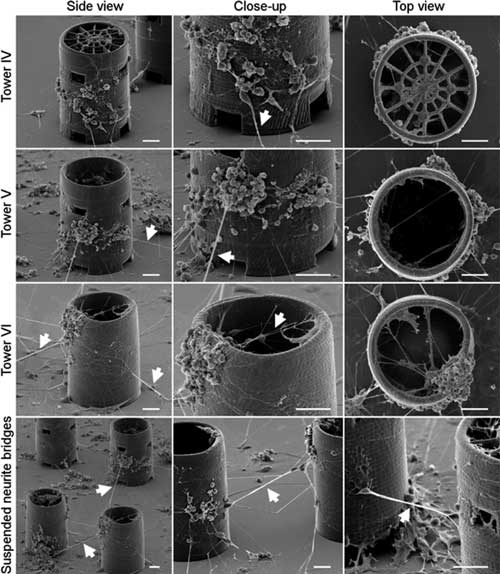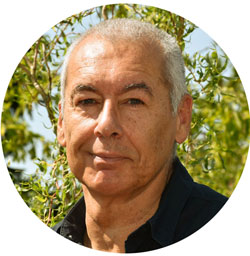| Posted: Aug 11, 2017 | |
3D cell culture platform based on direct laser written microtowers(Nanowerk News) In a new paper in ACS Applied Materials & Interfaces ("Direct Laser Writing of Tubular Microtowers for 3D Culture of Human Pluripotent Stem Cell-Derived Neuronal Cells"), researchers in Finland describe the optimization of the fabrication process for a novel, detailed, 3D cell culture platform based on direct laser written tubular microtowers and human neuronal cells. |
|
| Although two-photon polymerization (2PP-DLW) – a computer-assisted laser-based fabrication technique – is not an easily upscalable fabrication method such as electrospinning, it enables the repeatable production of platforms with fine details for in vitro applications. It is a powerfull tool to produce cell culture platforms with highly ordered geometries that recapitulate the structure and size scale of natural 3D cell environments. | |
 |
|
| SEM images of neuronal cells inside and outside of different microtower designs at the one-week time point. The images of the three upper rows show the towers from the tilt angles of 60° (first and second column) and 0° (third column). The last row illustrates the close-ups of the suspended neurite bridges extending between adjacent towers. Suspended neurite bridges are marked with arrowheads. Scale bars represent 20 µm. (© ACS) (click on image to enlarge) | |
| These easily tunable platforms can be used for studying the effects of the layout and the design (shapes and dimensions) on cell behavior. | |
| The aim of this present study was to polymerize different microtower designs including a design with intraluminal longitudinal micropillars that mimic the axonal tracts in vivo. | |
| In particular, the team investigated the ability of the towers to support the adhesion, growth, and orientation of human pluripotent stem cell (hPSC)-derived neuronal cells. | |
| The researchers fabricated six different microtower designs. They demonsytrated that these cell culture platforms are efficient for the long-term 3D culturing of human stem cell-derived neuronal cells. | |
| "Our proposed culturing concept may be used as a substitute for the hydrogel matrix commonly used to mechanically support the 3D growth of cells," the authors conclude their report. "The platform is especially suitable for studying cell behavior in a 3D environment, for example, the orientation and migration of neuronal cells, both of which are important aspects to consider in future studies." |
 By
Michael
Berger
– Michael is author of three books by the Royal Society of Chemistry:
Nano-Society: Pushing the Boundaries of Technology,
Nanotechnology: The Future is Tiny, and
Nanoengineering: The Skills and Tools Making Technology Invisible
Copyright ©
Nanowerk LLC
By
Michael
Berger
– Michael is author of three books by the Royal Society of Chemistry:
Nano-Society: Pushing the Boundaries of Technology,
Nanotechnology: The Future is Tiny, and
Nanoengineering: The Skills and Tools Making Technology Invisible
Copyright ©
Nanowerk LLC
|
|
|
Subscribe to a free copy of one of our daily Nanowerk Newsletter Email Digests with a compilation of all of the day's news. |
